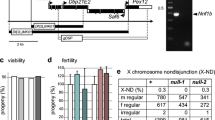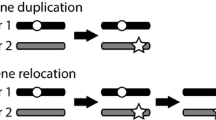Abstract
Despite their essential role in the process of chromosome segregation in eukaryotes, kinetochore proteins are highly diverse across species, being lost, duplicated, created, or diversified during evolution. Based on comparative genomics, the duplication of the inner kinetochore proteins CenH3 and Cenp-C, which are interdependent in their roles of establishing centromere identity and function, can be said to be rare in animals. Surprisingly, the Drosophila CenH3 homolog Cid underwent four independent duplication events during evolution. Particularly interesting are the highly diverged Cid1 and Cid5 paralogs of the Drosophila subgenus, which are probably present in over one thousand species. Given that CenH3 and Cenp-C likely co-evolve as a functional unit, we investigated the molecular evolution of Cenp-C in species of Drosophila. We report yet another Cid duplication (leading to Cid6) within the Drosophila subgenus and show that not only Cid, but also Cenp-C is duplicated in the entire subgenus. The Cenp-C paralogs, which we named Cenp-C1 and Cenp-C2, are highly divergent. Both Cenp-C1 and Cenp-C2 retain key motifs involved in centromere localization and function, while some functional motifs are conserved in an alternate manner between the paralogs. Interestingly, both Cid5 and Cenp-C2 are male germline-biased and evolved adaptively. However, it is currently unclear if the paralogs subfunctionalized or if the new copies acquired a new function. Our findings point towards a specific inner kinetochore composition in a specific context (i.e., spermatogenesis), which could prove valuable for the understanding of how the extensive kinetochore diversity is related to essential cellular functions.




Similar content being viewed by others
References
Afgan E, Baker D, van den Beek M, Blankenberg D, Bouvier D, Čech M, Chilton J, Clements D, Coraor N, Eberhard C et al (2016) The Galaxy platform for accessible, reproducible and collaborative biomedical analyses: 2016 update. Nucleic Acids Res 44:W3–W10
Casals F, Cáceres M, Manfrin M, González J, Ruiz A (2005) Molecular characterization and chromosomal distribution of Galileo, Kepler and Newton, three foldback transposable elements of the Drosophila buzzatii species complex. Genetics 169:2047–2059
Clément Y, Tavares R, Marais G (2006) Does lack of recombination enhance asymmetric evolution among duplicate genes? Insights from the Drosophila melanogaster genome. Gene 385:89–95
Comeron J, Ratnappan R, Bailin S (2012) The many landscapes of recombination in Drosophila melanogaster. PLoS Genet 8:e1002905
Dalal Y, Furuyama T, Vermaak D, Henikoff S (2007) Structure, dynamics, and evolution of centromeric nucleosomes. Proc Natl Acad Sci USA 104:15974–15981
Dawe R, Henikoff S (2006) Centromeres put epigenetics in the driver’s seat. Trends Biochem Sci 31:662–669
Des Marais DL, Rausher MD (2008) Escape from adaptive conflict after duplication in an anthocyanin pathway gene. Nature 454:762–765
Dias GB, Heringer P, Svartman M, Kuhn GCS (2015) Helitrons shaping the genomic architecture of Drosophila: enrichment of DINE-TR1 in α- and β-heterochromatin, satellite DNA emergence, and piRNA expression. Chromosome Res 23:597–613
Drinnenberg IA, deYoung D, Henikoff S, Malik HS (2014) Recurrent loss of CenH3 is associated with independent transitions to holocentricity in insects. eLife 3:e03676.
Edgar R (2004) MUSCLE: multiple sequence alignment with high accuracy and high throughput. Nucleic Acids Res 32:1792–1797
Ellegren H, Parsch J (2007) The evolution of sex-biased genes and sex-biased gene expression. Nat Rev Genet 8:689–698
Erhardt S, Mellone B, Betts C, Zhang W, Karpen G, Straight A (2008) Genome-wide analysis reveals a cell cycle-dependent mechanism controlling centromere propagation. J Cell Biol 183:805–818
Finseth F, Dong Y, Saunders A, Fishman L (2015) Duplication and adaptive evolution of a key centromeric protein in mimulus, a genus with female meiotic drive. Mol Biol Evol 32:2694–2706
Fishman L, Saunders A (2008) Centromere-Associated female meiotic drive entails male fitness costs in Monkeyflowers. Science 322:1559–1562
Gonzalez J, Nefedov M, Bosdet I, Casals F, Calvete O, Delprat A, Shin H, Chiu R, Mathewson C, Wye N et al (2005) A BAC-based physical map of the Drosophila buzzatii genome. Genome Res 15:885–889
Guillén Y, Rius N, Delprat A, Williford A, Muyas F, Puig M, Casillas S, Ràmia M, Egea R, Negre B et al (2014) Genomics of ecological adaptation in cactophilic Drosophila. Genome Biol Evol 7:349–366
Heeger S, Leismann O, Schittenhelm R, Schraidt O, Heidmann S, Lehner C (2005) Genetic interactions of separase regulatory subunits reveal the diverged Drosophila Cenp-C homolog. Genes Dev 19:2041–2053
Henikoff S, Ahmad K, Platero J, van Steensel B (2000) Heterochromatic deposition of centromeric histone H3-like proteins. Proc Natl Acad Sci USA 97:716–721
Henikoff S, Ahmad K, Malik H (2001) The centromere paradox: stable inheritance with rapidly evolving DNA. Science 293:1098–1102
Hughes LA (1994) The evolution of functionally novel proteins after gene duplication. Proc Biol Sci 256:119–124
Iwata-Otsubo A, Dawicki-McKenna JM, Akera T, Falk SJ, Chmátal L, Yang K, Sullivan BA, Schultz RM, Lampson MA, Black BE (2017) Expanded satellite repeats amplify a discrete CENP-A nucleosome assembly site on chromosomes that drive in female meiosis. Curr Biol 27:2365–2373.e8
Kuhn GCS, Ruiz A, Alves M, Sene FM (1996) The metaphase and polytene chromosomes of Drosophila seriema (repleta group; mulleri subgroup). Braz J Genet 19:209–216
Kursel L, Malik H (2017) Recurrent gene duplication leads to diverse repertoires of centromeric histones in Drosophila species. Mol Biol Evol 34:1445–1462
Kursel LE, Malik HS (2018) The cellular mechanisms and consequences of centromere drive. Curr Opin Cell Biol 52:58–65
Langmead B, Salzberg S (2012) Fast gapped-read alignment with Bowtie 2. Nat Methods 9:357–359
Liu Y, Petrovic A, Rombaut P, Mosalaganti S, Keller J, Raunser S, Herzog F, Musacchio A (2016) Insights from the reconstitution of the divergent outer kinetochore of Drosophila melanogaster. Open Biol 6:150236
Lynch M, Force A (2000) The probability of duplicate gene preservation by subfunctionalization. Genetics 154:459–473
Malik H, Henikoff S (2009) Major evolutionary transitions in centromere complexity. Cell 138:1067–1082
Meisel RP (2011) Towards a more nuanced understanding of the relationship between sex-biased gene expression and rates of protein-coding sequence evolution. Mol Biol Evol 28:1893–1900.
Nambiar M, Smith G (2016) Repression of harmful meiotic recombination in centromeric regions. Semin Cell Dev Biol 54:188–197
Oliveira D, Almeida F, O’Grady P, Armella M, DeSalle R, Etges W (2012) Monophyly, divergence times, and evolution of host plant use inferred from a revised phylogeny of the Drosophila repleta species group. Mol Phylogenet Evol 64:533–544
Orr B, Sunkel C (2011) Drosophila CENP-C is essential for centromere identity. Chromosoma 120:83–96
Pegueroles C, Laurie S, Albà MM (2013) Accelerated evolution after gene duplication: a time-dependent process affecting just one copy. Mol Biol Evol 30:1830–1842
Pimpinelli S, Berloco M, Fanti L, Dimitri P, Bonaccorsi S, Marchetti E, Caizzi R, Caggese C, Gatti M (1995) Transposable elements are stable structural components of Drosophila melanogaster heterochromatin. Proc Natl Acad Sci USA 92:3804–3808
Plohl M, Luchetti A, Meštrović N, Mantovani B (2008) Satellite DNAs between selfishness and functionality: structure, genomics and evolution of tandem repeats in centromeric (hetero)chromatin. Gene 409:72–82
Przewloka M, Venkei Z, Bolanos-Garcia VM, Debski J, Dadlez M, Glover DM (2011) CENP-C is a structural platform for kinetochore assembly. Curr Biol 21:399–405
Rius N, Guillén Y, Delprat A, Kapusta A, Feschotte C, Ruiz A. 2016. Exploration of the Drosophila buzzatii transposable element content suggests underestimation of repeats in Drosophila genomes. BMC Genom 17:344
Ross B, Malik H (2014) Genetic conflicts: stronger centromeres win tug-of-war in female meiosis. Curr Biol 24:R966–R968
Russo C, Mello B, Frazão A, Voloch C (2013) Phylogenetic analysis and a time tree for a large drosophilid data set (Diptera: Drosophilidae). Zool J Linn Soc 169:765–775
Rutkowska J, Badyaev A (2008) Meiotic drive and sex determination: molecular and cytological mechanisms of sex ratio adjustment in birds. Philos Trans R Soc B 363:1675–1686
Schaeffer S, Bhutkar A, McAllister B, Matsuda M, Matzkin L, O’Grady P, Rohde C, Valente V, Aguade M, Anderson W et al (2008) Polytene chromosomal maps of 11 Drosophila species: the order of genomic scaffolds inferred from genetic and physical maps. Genetics 179:1601–1655
Schittenhelm RB, Althoff F, Heidmann S, Lehner C (2010) Detrimental incorporation of excess Cenp-A/Cid and Cenp-C into Drosophila centromeres is prevented by limiting amounts of the bridging factor Cal1. J Cell Sci 123:3768–3779
Schuh M, Lehner CF, Heidmann S (2007) Incorporation of Drosophila CID/Cenp-A and CENP-C into centromeres during early embryonic anaphase. Curr Biol 17:237–243
Stanke M, Morgenstern B (2005) AUGUSTUS: a web server for gene prediction in eukaryotes that allows user-defined constraints. Nucleic Acids Res 33:W465–W467
Talbert P, Bryson T, Henikoff S (2004) Adaptive evolution of centromere proteins in plants and animals. J Biol 3:18
Tamura K, Stecher G, Peterson D, Filipski A, Kumar S (2013) MEGA6: molecular evolutionary genetics analysis version 6.0. Mol Biol Evol 30:2725–2729
van Hooff J, Tromer E, van Wijk LM, Snel B, Kops G (2017) Evolutionary dynamics of the kinetochore network in eukaryotes as revealed by comparative genomics. EMBO Rep. https://doi.org/10.15252/embr.201744102
Wagner G, Kin K, Lynch V (2012) Measurement of mRNA abundance using RNA-seq data: RPKM measure is inconsistent among samples. Theory Biosci 131:281–285
Walsh JB (1995) How often do duplicated genes evolve new functions? Genetics 139:421–428
Yang Z (2007) PAML 4: phylogenetic analysis by maximum likelihood. Mol Biol Evol 24:1586–1591
Zhang Z, Kishino H (2004) Genomic background predicts the fate of duplicated genes: evidence from the yeast genome. Genetics 166:1995–1999
Acknowledgements
We are very grateful to the two reviewers for all comments and insightful suggestions that significantly improved the quality of our work. We are also grateful to Dr. Maura Helena Manfrin (University of São Paulo) for providing us the D. seriema strain. This work was supported by grants from “Fundação de Amparo à Pesquisa do Estado de Minas Gerais” (FAPEMIG) (Grant Number APQ-01563-14) and “Conselho Nacional de Desenvolvimento Científico e Tecnológico” (CNPq) (Grant Number 404620/2016-7) to G.K.
Author information
Authors and Affiliations
Corresponding author
Electronic supplementary material
Below is the link to the electronic supplementary material.
239_2018_9851_MOESM1_ESM.png
Supplementary Figure S1 Some Cenp-C motifs are alternatively conserved between Cenp-C1 and Cenp-C2. (A) Schematic representation of the general motif structure of Drosophila subgenus Cenp-C. (B) Logo representations for each motif of the Drosophila subgenus Cenp-C1 (C1) and Cenp-C2 (C2). Motifs are as follow: R-rich, arginine-rich; DH, drosophilid Cenp-C homology; AT1, AT hook 1; NLS, nuclear localization signal; CenH3 binding, also known as Cenp-C motif; AT2, AT hook 2; Cupin, a dimerization domain near the C-terminal region. The asterisk in the CenH3 binding motif indicates the corresponding R1101 of D. melanogaster, which is essential for the centromere localization of Cenp-C1. (PNG 3201 KB)
Rights and permissions
About this article
Cite this article
Teixeira, J.R., Dias, G.B., Svartman, M. et al. Concurrent Duplication of Drosophila Cid and Cenp-C Genes Resulted in Accelerated Evolution and Male Germline-Biased Expression of the New Copies. J Mol Evol 86, 353–364 (2018). https://doi.org/10.1007/s00239-018-9851-y
Received:
Accepted:
Published:
Issue Date:
DOI: https://doi.org/10.1007/s00239-018-9851-y




